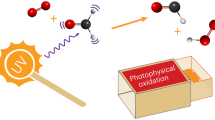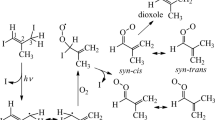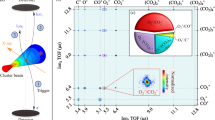Abstract
CONNECTIONS between polar ozone depletion and halocarbon chemistry have been established by a number of studies1–10. Recent attempts to account quantitatively for the observed rate of ozone decline in Antarctica in terms of known photochemical processes have not been entirely successful, and it seems that further chemical ozone-depleting mechanisms may be needed, particularly if the transport of ozone into the polar regions competes with chemical losses. Spectroscopic and photochemical data indicate that photolysis of OCIO may provide a further ozone loss mechanism that has not previously been considered. Here we report laboratory studies of OCIO spectroscopy and photoproducts which suggest that atomic Cl and O2 are formed to some extent in the photodis-sociation process. This evidence points towards possible photo-isomerization to the unstable species ClOO, (or at least to a similar metastable intermediate) probably by way of the 2B2 excited state of OClO, thus reinforcing the idea that photolysis of OC1O may contribute to polar ozone depletion.
This is a preview of subscription content, access via your institution
Access options
Subscribe to this journal
Receive 51 print issues and online access
$199.00 per year
only $3.90 per issue
Buy this article
- Purchase on Springer Link
- Instant access to full article PDF
Prices may be subject to local taxes which are calculated during checkout
Similar content being viewed by others
References
Farman, J. C., Gardiner, B. G. & Shanklin, J. D. Nature 315, 207–210 (1985).
Stolarski, R. S. et al. Nature 322, 808–811 (1986).
Hofmann, D. J., Harder, J. W., Rolf, S. R. & Rosen, J. M. Nature 326, 59–62 (1987).
Gardiner, B. G. & Shanklin, J. D. Geophys. Res. Lett. 13, 1199–1201 (1986).
Solomon, S., Garcia, R. R., Rowland, F. S. & Wuebbles, D. J. Nature, 321, 755–758 (1986).
McElroy, M. B., Salawitch, R. J., Wofsy, S. C. & Logan, J. A. Nature 321, 759–762 (1986).
Crutzen, P. J. & Arnold, F. Nature 324, 651–655 (1986).
Barrett, J. W. et al. Nature 336, 455–458 (1988).
Anderson, J. G., Brune, W. R. & Chan, R. J. geophys. Res. 94, 11480–11520 (1989).
Jones, R. L. et al. J. geophys. Res. 94, 11529–11558 (1989).
Sander, S., Friedl, R. & Yung, Y. Science 245, 1095–1097 (1989).
Pyle, J. A. Geophys. Res. Lett. 13, 1320–1322 (1986).
Tuck, A. F. J. geophys. Res. 94, 11687–11737 (1989).
Coon, J. B. & Ortiz, E. J. molec. Spectrosc. 1, 81–94 (1957).
Wahner, A., Tyndall, G. S. & Ravishankara, A. R. J. phys. Chem. 91, 2734–2738 (1987).
Brand, J. C. D., Redding, R. W. & Richardson, A. W. J. molec. Spectrosc. 34, 399–414 (1970).
Gole, J. L. J. Phys. Chem. 84, 1333–1340 (1980).
Michielsen, S. et al. J. chem. Phys. 74, 3089–3101 (1981).
McDonald, P. A. & Innes, K. K. Chem. Phys. Lett. 59, 562–566 (1978).
Richard, E. C., Wickham-Jones, C. T. & Vaida, V. J. phys. Chem. 93, 6346–6350 (1989).
Lipscomb, F. J., Norrish, R. G. W. & Thrush, B. A. Proc. R. Soc. A 233, 455–464 (1956).
Bethune, D. S., Schell-Sorokin, A. J., Lankard, J. R., Loy, M. M. T. & Sorokin, P. P. in Advances in Laser Spectroscopy. Vol. 2 (eds Garetz, B. A. & Lombardi, J. R.) (Wiley Chichester, 1983).
Glownia, J. H., Misewich, J. & Sorokin, P. P. in Supercontinuum Laser Sources (ed. Alfano, R. R. (Springer, Berlin, in the press).
Hayman, G. D. & Cox, R. A. Chem. Phys. Lett. 155, 1–7 (1989).
Colussi, A. J., Redmond, R. W. & Scaiano, J. C. J. phys. Chem. 93, 4783–4785 (1989).
Hodges, R. V., Lee, L. C. & Moseley, J. T. Int. J. Mass Spectrom. Ion Phys. 39, 133–143 (1981).
Arkell, A. & Schwager, I. J. Am. chem. Soc. 89, 5999–6006 (1967).
Adrian, F. J., Bohandy, J. & Kim, B. F. J. chem. Phys. 85, 2692–2698 (1986).
Donaldson, D. J., Gaines, G. A. & Vaida, V. J. phys. Chem. 92, 2766–2769 (1988).
Sapers, S. P., Vaida, V. & Naaman, R. J. chem. Phys. 88, 3638–3645 (1988).
Donaldson, D. J., Richard, E. C., Strickler, S. J. & Vaida, V. J. phys. Chem. 92, 5514–5517 (1988).
Donaldson, D. J., Child, M. S. & Vaida, V. J. chem. Phys. 88, 7410–7417, (1988).
Vaida, V., Donaldson, D. J., Sapers, S. P., Naaman, R. & Child, M. S. J. phys. Chem. 93, 513–520 (1989).
Prinslow, D. A. & Vaida, V. J. phys Chem. 93, 1836–1840 (1989).
Solomon, S., Mount, G. H., Sanders, R. W. & Schmeltekopf, A. L. J. geophys. Res. 92, 8329–8338 (1987).
Solomon, S., Sanders, R. W., Carroll, M. A. & Schmeltekopf, A. L. J. geophys. Res. 94, 11393–11404 (1989).
Author information
Authors and Affiliations
Rights and permissions
About this article
Cite this article
Vaida, V., Solomon, S., Richard, E. et al. Photoisomerization of OCIO: a possible mechanism for polar ozone depletion. Nature 342, 405–408 (1989). https://doi.org/10.1038/342405a0
Received:
Accepted:
Published:
Issue Date:
DOI: https://doi.org/10.1038/342405a0
This article is cited by
-
Theoretical study of the mechanism for the ClOO + NO reaction on the singlet potential energy surface
Structural Chemistry (2012)
Comments
By submitting a comment you agree to abide by our Terms and Community Guidelines. If you find something abusive or that does not comply with our terms or guidelines please flag it as inappropriate.



